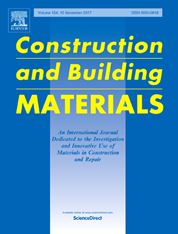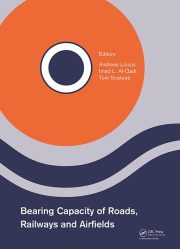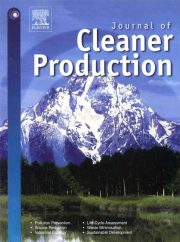Comparison of the 3-dim linear viscoelastic behavior of asphalt mixes determined with tension-compression and dynamic tests
Jean-Claude Carret, Alvaro Pedraza, Hervé Di Benedetto, Cédric Sauzeat
Construction and Building Materials, Volume 174, 20 June 2018, Pages 529-536
Abstract
In this paper, conventional cyclic tension-compression tests and dynamic measurements have been applied to three cylindrical specimens of asphalt mixes. The results of the two tests have been compared. For the tension-compression tests, the complex modulus was obtained from the measurements of the axial stress and axial strain. For the dynamic testing, an instrumented impact hammer and an accelerometer have been used to obtain the frequency response functions of the specimens at different temperatures. The dynamic complex modulus was then back calculated by optimizing finite element calculated frequency response functions to match the measured frequency response functions. The 2S2P1D linear viscoelastic model was used to estimate master curves of the complex modulus for the two test methods. The two tests give similar results. However, the dynamic measurements give a higher value of the norm of the complex modulus and a lower value of the phase angle compared to the tension–compression results. This result is probably explained by the nonlinearity of asphalt mixes as dynamic tests are performed at a much smaller strain level than the tension-compression tests.
Propriétés thermomécaniques d’enrobés multi-recyclés
Résumé
Les premiers recyclages d’enrobés bitumineux à 50% sont apparus sur autoroutes françaises dans les années 1990 – une charte de l’innovation spécifique aux enrobés drainants intégrant 50% de recyclés fut notamment délivrée début 2002 (SETRA – CSTR, 2002). Un nouveau cycle de recyclage à fort taux de ces tout premiers enrobés a été entrepris ici ou là, depuis quelques années. Le multirecyclage des agrégats d’en-robé (AE) dans les mélanges d’enrobés bitumineux est de ce fait une problématique actuelle, qui va se gé-néraliser dans l’avenir, lorsqu’il faudra recycler des enrobés contenant déjà des enrobés recyclés plusieurs fois. Le projet visant à étudier le MUlti-Recyclage des Enrobés tièdes a été labellisé projet national (PN MURE). Une part du projet MURE regroupant des aspects scientifiques particuliers a été regroupé au sein du projet « IMPROVMURE », financé par l’Agence Nationale de la Recherche, et qui a débuté en mars 2014. L’objectif du projet « Innovation en Matériaux et PROcédés pour la Valorisation du MUlti-Recyclage des En-robés » (IMPROVMURE) est de fournir des éléments de réponse raisonnés et quantifiés, en laboratoire et sur sites pilotes, afin de faire du multi-recyclage des enrobés fabriqués à chaud et tiède. Les questions sociétales, environnementales, règlementaires ou normatives sont également prises en compte dans le cadre du projet. Un des objectifs du projet IMPROVMURE est l’étude des propriétés thermomécaniques des enrobés. C’est dans le cadre de cet objectif que s’inscrit le travail de thèse présenté dans ce document. Cette thèse est le fruit d’une collaboration entre le Laboratoire Génie Civil et Bâtiment de l’ENTPE (LGCB)/Laboratoire de Tribologie et Dynamique des Systèmes (LTDS) et l’entreprise EIFFAGE Infrastructures. 15 types d’enrobés ont été testés pour l’étude des propriétés thermomécaniques des enrobés multi-recyclés. Les enrobés diffèrent par leur condition de fabrication (Laboratoire ou chantier), leur procédé de fabrication (chaud ou tiède mousse), le taux d’agrégat d’enrobé introduit (0%, 40%, 70% ou100%) et le nombre de cycles de recyclage (un, deux ou trois). Trois caractéristiques ont été communes à tous les types d’enrobés fabriqués, sauf pour l’enrobé contenant 100% d’agrégats d’enrobé. La première est la même courbe granulométrique des granulats, la troisième est la teneur en liant de 5.4% en masse et la troisième est le type d’enrobé « Béton Bitumineux Semi-Grenu » (BBSG) de type 03 selon la norme EN 13108-1. Trois domaines du comportement des enrobés bitumineux ont été étudies : Viscoélasticité linéaire (VEL), couplage thermomécanique à basse température et fissuration à froid. Pour le domaine de comportement VEL, les enrobés bitumineux ont été étudiés à l’aide des essais de module complexe en traction-compression réalisés sur une large gamme de températures et de fréquences sur éprouvette cylindrique à l’ENTPE. Les résultats sont modélisés à l’aide du modèle analogique 2S2P1D qui a été développé au laboratoire LGCB de l’ENTPE. Des essais de propagation d’ondes ont aussi été réalisés. La méthode de détermination du temps de vol des ondes « P » et des ondes « S » et la méthode Impact Résonance sont utilisées. Ces essais utilisent des méthodes non destructives et faciles à réaliser. On peut ainsi calculer les valeurs de modules et de coefficients de Poisson des matériaux. Puis, le couplage thermomécanique à basse température est caractérisé à l’aide de l’essai de retrait thermique empêché (TSRST), qui utilise le même dispositif que l’essai de module complexe mais les éprouvettes utilisées sont de géométrie différente. Finalement des essais de propagation de fissure ont été réalisés avec des sollicitations monotones. La propagation de la fissure suivie utilisant la méthode de corrélation des images. Des estimations de la hauteur de fissure ont été faites sur la basse de la méthode DRCL développée à l’ENTPE.
Mouillabilité et miscibilité des bitumes : application au recyclage
Sabine Vassaux
Thèse de doctorat, septembre 2017
Résumé
—
Linear viscoelastic behaviour of bituminous mixtures with multi-recycled asphalt pavement
Pedraza A., Di Benedetto H., Sauzéat C., Pouget S.
10th Int. Conf. Bearing Capacity of Roads Railways and Airfields (BCRRA), p. 8
28-30 June 2017
Abstract
—
Evaluation of bituminous binders miscibility for warm-mix recycling techniques
Vassaux S., Gaudefroy V., Soro L.J., Pévère A., Mouillet V., Boulangé L., Barragan-Montero V.
10th Int. Conf. Bearing Capacity of Roads Railways and Airfields (BCRRA)
28-30 June 2017
Abstract
—
Towards a better understanding of wetting regimes at the interface asphalt/aggregate during warm-mix process of asphalt mixtures
S. Vassaux, V. Gaudefroy, L. Boulangé, A. Pévère, V. Mouillet, V. Barragan-Montero
Construction and Building Materials, Volume 133, 15 February 2017, Pages 182-195
Abstract
In road applications, the current challenge is to develop more ecological products while maintaining asphalt mixture performance and durability. This sustainable development politics in civil engineering leads to promote techniques saving both energy and raw materials like combining the use of warm mix asphalt concretes (WMA) with the use of reclaimed asphalt pavement (RA). However, one of the current problematic when combining WMA and RA is to assess the quality adhesion of the “asphalt/aggregate” couple that is a fundamental parameter for the good mixture properties at short time and thereby durability of this composite structure. Indeed, the reduction of the manufacture temperature and the use of an aged binder may also have consequences on adhesion quality between asphalt and aggregates. It is the reason why it is crucial to identify the most impacting factors of wetting phenomena at the interface “asphalt/aggregate”. So, in this paper, the role of asphalt characteristics (viscosity, ageing, composition) as well as the one of substrate was investigated.
The substrate heterogeneity degree determines asphalt wetting behavior. For a model glass substrate, only asphalt characteristics have an impact: asphalt viscosity, polarity and saturates content are influent factors. On the mineral heterogeneous substrate, asphalt viscosity and asphaltenes content have an impact on wetting indicators. Substrate heterogeneities also appear as a very important factor which improves considerably wetting quality. The tested mineral substrate has been revealed as a biphasic composite material for which the wetting regime was modeled by a Cassie-Baxter model. A comprehensive approach has been proposed to explain asphalt wetting on heterogeneous substrates in correlation with Scanning Electron Microscopy observations. This Cassie-Baxter model is essential to understand adhesion phenomena on heterogeneous road materials. It seems also to be a promising way to evaluate quality adhesion of “asphalt/RA” mixtures.
Bitumen extraction and recovery in road industry: A global methodology in solvent substitution from a comprehensive review
L. Ziyani, L. Boulangé, A. Nicolaï, V. Mouillet
Journal of Cleaner Production, Volume 161, 10 September 2017, Pages 53-68
Abstract
In the roadworks sector, extraction is a crucial step that consists of separating the bituminous binder from the mineral matter in asphalt mixture or reclaimed asphalt using a chlorinated solvent before the characterisation of binders’ properties and content. This review, conducted on scientific articles, technical papers and standards from 1996 to 2016, combined all existing bitumen extraction/recovery methods to toxicological data and health concerns as well as inputs on circular economy and sustainability of solvents. Nearly 50% of the documents dated from 2001 and found in this study deal with these latest aspects. There are ten different methods for extracting and two methods for recovering bituminous binders using eight of the most common solvents. One crucial point highlighted by the literature is that the nature of solvent has a significant impact on the final properties of the recovered binder. The quality of extraction and binder recovery operations largely depends on the solubility of the binder in relation to the solvent. According to the calculated Hansen solubility parameters, the lowest relative energy difference parameters (solubility study) are obtained using perchloroethylene, 1,1,1-trichloroethane and xylene solvents. This means that these solvents are the most compatible with bitumen. There is a relationship between the relative energy difference and the octanol/water partition coefficient currently used in the environmental risk assessment. All the Strengths, Weaknesses, Opportunities, Threats of different extraction and recovery methods currently in use highlights the fact that at this time, there are no alternative products that are as effective under the current technical conditions of use as chlorinated solvents. This represents a challenge for new research in the trade industry and in health institution to find a substitute for chlorinated products that meets all the sustainability and circular economy criteria.





